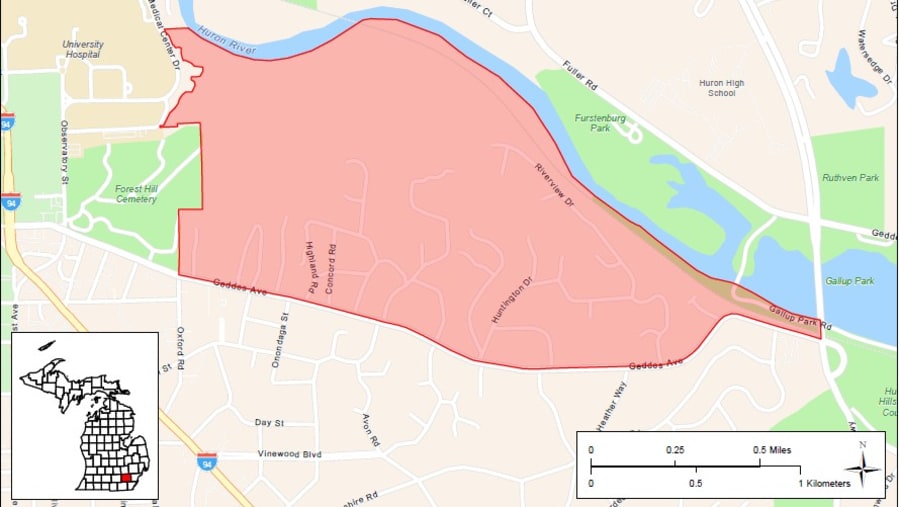ANN ARBOR, Mich. – Michigan officials are expanding the state’s interior hemlock woolly adelgid quarantine areas.
The new quarantine goes into effect on Tuesday, Aug. 1. The updated quarantine now includes Benzie County, Manistee County, and a portion of Washtenaw County in and around the Nichols Arboretum.
The quarantine regulates the movement of hemlock and tiger-tail spruce trees, forest products and nursery stock, with some exceptions, from the quarantine areas to other locations within the state.
“Our goal is to protect the 170 million hemlock trees that live in Michigan’s forests,” said Mike Philip, Director of MDARD’s Pesticide and Plant Pest Management Division. “According to the U.S. Department of Agriculture Forest Service, hemlock trees have a strong impact on streamside habitat conditions and stream health. Loss of hemlock could result in a rise in water temperatures in streams and an increase in soil erosion, something Michiganders certainly don’t need to further experience.”
The previous interior hemlock woolly adelgid quarantine regulated movement of hemlock in Allegan, Mason, Muskegon, Oceana, and Ottawa counties.
“If left unchecked, hemlock woolly adelgid could spread throughout Michigan’s hemlock trees, causing significant losses and affecting the timber and lumber industries, nursery and landscaping industries, the Christmas tree industry, and the tourist industry,” Philip said. “Hopefully, by expanding quarantine area, we can keep the pest from moving to new areas in the state and slow the spread within the currently infested areas.”

What you can do to help
Winter is the best time to look for evidence of an infestation. As the tiny, soft-bodied insects feed, they consume a hemlock’s stored nutrients and slowly suck the life from the tree.
“Cooler temperatures trigger feeding activity,” Robert Miller, MDARD’s invasive species prevention and response specialist said. “As hemlock woolly adelgids feed, they secrete a white, waxy material that creates ovisacs. The presence of these small, round, white masses makes it possible to identify infested trees.”
Hemlock trees can be protected with insecticide treatments. During the survey, infested trees and any other hemlocks within the area will be mapped and tagged for summer treatment.
If you have hemlocks on your property, you should take some time to check for signs of infestation. Hemlock trees are found in moist soils along streams and riverbanks and along coastal dunes. Hemlock also is popular as a landscape tree in parks and residential areas.
---> Meet Michigan’s 8 invasive insects: What they are, the damage they cause and what to do about them
How to identify a hemlock tree

The adelgids feed and form ovisacs only on eastern hemlock trees in Michigan, which is why it’s important to distinguish them from other conifers like pines or spruces.
The DNR suggests looking for the following:
- Cone- or egg-shaped trees up to 75 feet tall.
- Drooping or feathery branches.
- Flat needles growing individually from the sides of twigs.
- Needles that are dark green on top with two parallel, white stripes underneath.
- Papery cones about three-quarters of an inch long that hang downward from branches.
You should look on the undersides of branches for evidence of round, white ovisacs near the base of the needles. Up close, ovisacs look like tiny cotton balls and may appear alone or in clusters.
How to report infested hemlock trees
If you find an infested hemlock tree, you can report it by using the Midwest Invasive Species Information Network online by clicking here.
Reports also can be made by email to MDA-Info@Michigan.gov or by phone to MDARD’s Customer Service Center at 800-292-3939.
Share the location of the infested trees and try to take one or two pictures of infested branches to help confirm identification. To avoid spreading hemlock woolly adelgid, do not collect sample branches or twigs.

How hemlock trees can be treated
There are certain insecticides that can successfully treat the infestation if used correctly.
Without treatment, infested trees can die within four to 10 years. A qualified arborist can diagnose and assist with treating infested trees.
If you are able to handle treatment on your own, the DNR recommends following guidance from the MSU Extension bulletin here.
Even if you plan to handle treatment on your own, you should still report the infestation so officials can track where hemlock woolly adelgid has spread.




